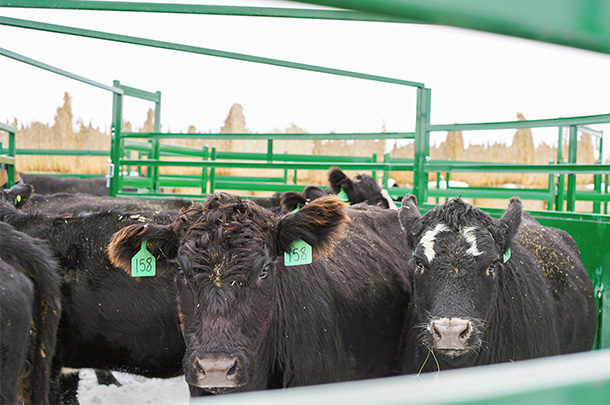With winter quickly approaching, preparing your ranch’s cattle-handling equipment, buildings and machinery becomes time-sensitive. It’s critical that livestock are handled safely and that handlers remain productive even when Mother Nature drops the temperature. Here are a few helpful tips to ensure your cattle operation is ready for whatever winter weather has in store.
1. Complete essential work while the weather allows
These jobs must occur before they become impossible due to snow and frozen ground. Straighten and reinforce any leaning gate posts and for long-term effectiveness, consider pouring concrete around them (more than a foot) to ensure gates swing properly even when frost heaves the ground. Pour any needed cement pads around water bowls and feedbunks or under cattle squeeze chutes. This is the perfect time to make one or two targeted additions to your handling system. They might include a concrete foundation for an upgraded cattle squeeze chute, a new palpation cage or extra portable panels.
2. Make water bowl repairs and check electrical components
Take advantage of a warm sunny afternoon and assess all water bowls, heating elements and heat tape for potential issues. Inspect floats and water valves for damage and leaks. Valves become clogged with grit, so ensure they seat properly with the water turned on. Check pan elements and electrical wiring for concerns. A multimeter is handy to confirm the continuity of electrical current. It’s advisable to replace any suspect parts such as valves, elements or heat tape early, rather than discovering an overflowing water bowl and massive ice slick in subzero weather.
3. Inspect cattle handling equipment and address any problems
Cattle squeeze chutes, alleys and tubs are the workhorses of a ranch. They require upkeep and will occasionally require minor repairs. Watch for damaged and rusted metal, cracked or broken welds, faulty springs, missing chains, lost pins or defective gate and door latches. Ensure that flawed metal surfaces are welded, ground smooth or replaced to prevent injuries to livestock and workers, and replace any damaged or leaking hoses or fittings on hydraulic chutes. If you are having difficulty repairing or replacing parts, or need to replace any equipment prior to winter, be sure to choose a manufacturer with a solid warranty program and customer service team.
Pay special attention to the ground around and in front of the chute area, as it can become dug out over time. Calves may injure their rear tendons when leaving the chute, plus handlers can easily twist an ankle working around dangerous holes. Fill and smooth these areas with dirt or sand and think about adding traction-assisted rubber mats.
4. Be liberal with lubrication
As the temperature drops, moving parts on handling equipment become stiffer and harder to manipulate. To reduce these challenges, make sure all joints are free of debris and lubricated regularly with oil or WD-40. Use lightweight grease for main pivot points on headgates and rolling door wheels and lubricate tub hinges and access gates for easy operation. Don’t forget to top up the hydraulic chute’s oil reservoir.
5. Repair roofs and walls to control drafts
If your processing system is indoors, check and repair any areas, including ceilings and roofs, that might allow snow, rain or drafts in. Replace any cracked or broken windows and ensure they open and close properly. Make sure doors function smoothly. Consider adding a propane or electric heater to the squeeze chute area to keep vaccines, drugs, syringes and people from freezing in the case of an emergency.
6. Service all motorized machinery and feed equipment
In challenging weather, the necessities of life become even more critical. Feeding, bedding and snow-removal machinery should be a constant focus. All motorized and mechanical equipment – including tractors, skid steers, loaders, feed wagons and bale shredders – will need servicing, repairing or upgrading. Since an emergency trip to the veterinary clinic might be necessary, make sure your livestock trailer is lined and draft resistant. Check all tires for wear and proper inflation, plus make a grease and oil tour focusing on bearings, drivelines and gearbox fluid levels. And, by all means, pull the snowplow or blade out of the bush before an ill-timed snowstorm blocks it in.
7. Complete a final cleanup of unnecessary tools and manure from the yard and cattle-handling areas
No one enjoys tripping over tools and equipment, so enlist the family for an afternoon “adventure hike” around the yard, picking up forgotten tools, garbage, wood, metal scraps and any other misplaced or unnecessary summer items. Complete a last-minute cleanup of manure and straw from the squeeze chute, alleys, tubs and gate areas to protect metal and ensure swivel points and latches work as they are meant to.
8. Create an emergency plan
Although no one wishes for emergencies, it’s helpful to put together a plan to deal with extreme weather-related problems should they occur. A specifically tailored winter survival kit is an excellent idea. It could contain at minimum: water, nonperishable snacks, a first-aid kit, flashlights, extra batteries, candles, a fire extinguisher, matches, basic tools, pencil and paper, a whistle or horn to call for help, basic vet supplies and extra winter clothing. Lastly, make sure to have a list handy of all emergency contact phone numbers, such as the veterinarian, close neighbors and the insurance company.
Setting aside a day while the weather is cooperating to ensure that cattle-handling equipment, gates, buildings and machinery are ready for the coming winter weather is well worth your time and effort. These basic tips might be the deciding factor between a well-run productive ranch and an operation faced with unmanageable problems in the midst of winter.









